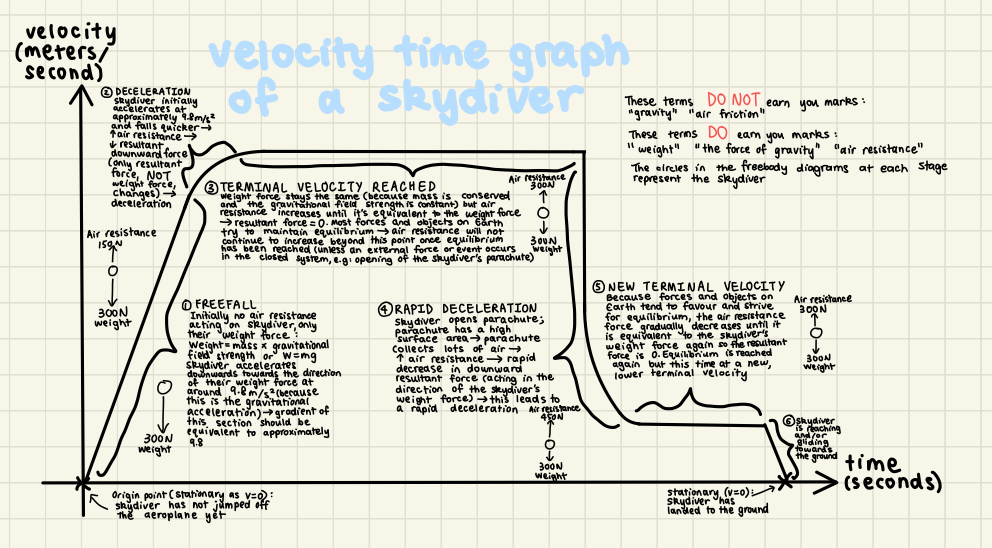1.19-1.21 Car Safety & Terminal Velocity
0.0(0)
Card Sorting
1/12
Earn XP
Description and Tags
Study Analytics
Name | Mastery | Learn | Test | Matching | Spaced |
|---|
No study sessions yet.
13 Terms
1
New cards
Stopping distance
Total distance travelled during the time it takes for a car to stop when a driver responds to a hazard.
2
New cards
Thinking distance
Distance travelled during the time it takes for the driver to react (reaction time) to the hazard.
3
New cards
Braking distance
Distance travelled under the braking force when the brakes are applied.
4
New cards
Stopping distance formula
Stopping distance = Thinking distance + Braking distance
5
New cards
Factors affecting stopping distance
1. Vehicle speed
2. Vehicle mass
3. Road/weather/tyre conditions
4. Reaction time
6
New cards
Vehicle speed’s effect on stopping distance
↑ speed → ↑ KE → brakes need to do ↑ work to stop vehicle under given braking force → ↑ time needed to do this work → ↑ stopping distance
7
New cards
Vehicle mass’ effect on stopping distance
↑ mass (e.g. more passengers, heavier loads, etc) → ↑ KE for moving the vehicle → brakes need to do ↑ work to stop vehicle under given braking force → ↑ time required to do this work of transferring KE to other energy form so vehicle stops → ↑ stopping distance
8
New cards
Road/weather/tyre conditions effect on stopping distance
Poor road conditions (e.g. gravel), poor weather (wet/icy roads), or worn tyres/brakes → ↓ friction → ↑ time for work to be done (for KE to be transferred to other energy form to stop vehicle) → ↑ stopping distance.
9
New cards
Reaction time effect on stopping distance
↓ reaction time → ↓ thinking distance → ↓ stopping distance (caffeine, a type of drug can increase alertness and therefore reduce reaction time).
↑ reaction time → ↑ thinking distance → ↑ stopping distance (fatigue, distractions, drugs/alcohol/intoxication can have these effects on drivers).
↑ reaction time → ↑ thinking distance → ↑ stopping distance (fatigue, distractions, drugs/alcohol/intoxication can have these effects on drivers).
10
New cards
What forces do falling objects experience?
Weight (due to gravity)
Air resistance (due to friction)
Air resistance (due to friction)
11
New cards
What happens when an object falls?
1. Upwards air resistance force is small to begin with (because the object doesn’t fall very quickly to begin with as it transitions from stationary to falling).
2. Object’s weight due to Earth’s gravitational pull is much larger than upwards air resistance → large resultant force going downwards (weight) → object initially accelerates downwards.
3. Acceleration downwards → ↑ speed → ↑ collisions between air molecules and object → ↑ friction → ↑ air resistance → the faster it falls, the higher the air resistance.
4. Air resistance eventually grows large enough to balance weight forces (remember weight stays constant as object’s mass is conserved).
5. Air resistance = weight → resultant force = 0 → no acceleration → object now travels at constant speed.
1. F = ma
2. Resultant force = 0 → 0 = ma → a (acceleration) = 0; mass should not be 0 because the object’s mass should supposedly stay the same during its free fall (law of conservation of mass)
6. After terminal velocity, air resistance will not continue to increase (unless you open a parachute of course) because most forces as well as objects on Earth endeavour to maintain equilibrium
12
New cards
Terminal velocity
The constant speed a free-falling object reaches when air resistance is equal to the object’s weight and it experiences no acceleration.
13
New cards
Velocity-time graph of skydiver and free body diagrams to show how the weight and air resistance/drag force change at each stage
Large resultant force when there was initially no air resistance
Smaller resultant force when air resistance gradually increased (causing deceleration in stage 2)
0 resultant force when terminal velocity was reached and equilibrium was attained (in stage 3 as well as 5)
Smaller resultant force when air resistance gradually increased (causing deceleration in stage 2)
0 resultant force when terminal velocity was reached and equilibrium was attained (in stage 3 as well as 5)
